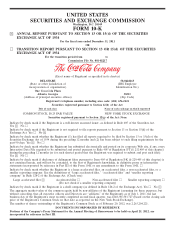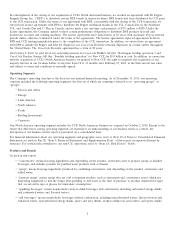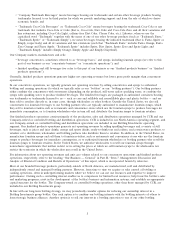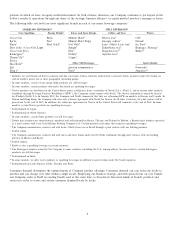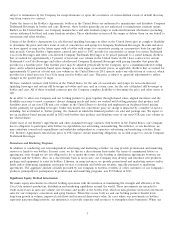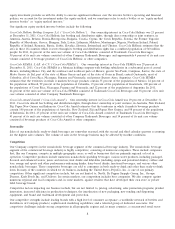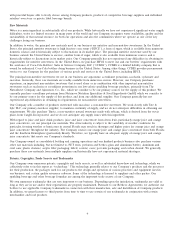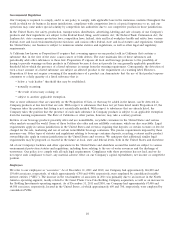Coca Cola 2011 Annual Report Download - page 7
Download and view the complete annual report
Please find page 7 of the 2011 Coca Cola annual report below. You can navigate through the pages in the report by either clicking on the pages listed below, or by using the keyword search tool below to find specific information within the annual report.During 2011, our Company introduced a variety of new brands, brand extensions and new beverage products. The Latin America
group launched Frugos Sabores Caseros, a juice nectar targeted to capture the homemade juice category, in Peru, and leveraged
its existing portfolio through search and reapply initiatives such as Powerade ION4, glac´
eau smartwater, Del Valle Limon & Nada
and Burn, an energy drink. In the Pacific group, Fanta, a fruit-flavored sparkling beverage, was relaunched in Singapore and
Malaysia after a significant period of absence from those markets; Real Leaf, a green tea-based beverage, extended its footprint
with launches of two varieties in Vietnam; and in South Korea we introduced three flavor variants of the Georgia Emerald
Mountain Blend ready-to-drink coffee beverage and Burn Intense, an energy drink. The Europe group saw the launch of
Powerade ION4 in Denmark, Norway, Sweden and France, with France also launching Powerade Zero. In the Eurasia and Africa
group, Turkey saw the launch of Cappy Pulpy, and India launched Fanta Powder, an orange-flavored powder formulation.
Schweppes Novida, a sparkling malt drink, was launched in Kenya and Uganda; and in Uganda we also launched Coca-Cola Zero.
In Egypt, we launched Cappy Fruitbite, the Company’s first juice drink with real fruit pieces in that market, and Schweppes Gold,
a sparkling flavored malt drink. In addition, in Ghana, we launched Schweppes Malt, a dark malt drink.
In furtherance of our commitments to sustainability and innovation, our PlantBottle technology, which allows us to replace
100 percent petroleum-based PET plastic with PET plastic that contains up to 30 percent material derived from plants, is
becoming more widely used around the world. By the end of 2011, PlantBottle packaging was available in 20 countries, and nearly
10 billion PlantBottle packages had been shipped. Also in 2011, the availability of our Coca-Cola Freestyle fountain dispenser
expanded in the United States to over 2,000 locations in 44 states. In addition, we added 19 beverages to bring the number of
regular and low-calorie beverage choices available on Coca-Cola Freestyle to 125 in honor of the Company’s 125th anniversary.
We measure the volume of Company beverage products sold in two ways: (1) unit cases of finished products and (2) concentrate
sales. As used in this report, ‘‘unit case’’ means a unit of measurement equal to 192 U.S. fluid ounces of finished beverage (24
eight-ounce servings); and ‘‘unit case volume’’ means the number of unit cases (or unit case equivalents) of Company beverage
products directly or indirectly sold by the Company and its bottling partners (the ‘‘Coca-Cola system’’) to customers. Unit case
volume primarily consists of beverage products bearing Company trademarks. Also included in unit case volume are certain
products licensed to, or distributed by, our Company, and brands owned by Coca-Cola system bottlers for which our Company
provides marketing support and from the sale of which we derive economic benefit. In addition, unit case volume includes sales by
joint ventures in which the Company has an equity interest. We believe unit case volume is one of the measures of the underlying
strength of the Coca-Cola system because it measures trends at the consumer level. The unit case volume numbers used in this
report are derived based on estimates received by the Company from its bottling partners and distributors. Concentrate sales
volume represents the amount of concentrates and syrups (in all cases expressed in equivalent unit cases) sold by, or used in
finished beverages sold by, the Company to its bottling partners or other customers. Unit case volume and concentrate sales
volume growth rates are not necessarily equal during any given period. Factors such as seasonality, bottlers’ inventory practices,
supply point changes, timing of price increases, new product introductions and changes in product mix can impact unit case
volume and concentrate sales volume and can create differences between unit case volume and concentrate sales volume growth
rates. In addition to the items mentioned above, the impact of unit case volume from certain joint ventures, in which the
Company has an equity interest, but to which the Company does not sell concentrates or syrups, may give rise to differences
between unit case volume and concentrate sales volume growth rates.
Distribution System and Bottler’s Agreements
We make our branded beverage products available to consumers in more than 200 countries through our network of Company-
owned or controlled bottling and distribution operations as well as independently owned bottling partners, distributors, wholesalers
and retailers — the world’s largest beverage distribution system. Consumers enjoy finished beverage products bearing our
trademarks at a rate of more than 1.7 billion servings each day. We continue to expand our marketing presence and increase our
unit case volume in developed, developing and emerging markets. Our strong and stable system helps us to capture growth by
manufacturing, distributing and marketing existing, enhanced and new innovative products to our consumers throughout the world.
The Coca-Cola system sold approximately 26.7 billion, 25.5 billion and 24.4 billion unit cases of our products in 2011, 2010 and
2009, respectively. Sparkling beverages represented approximately 75 percent, 76 percent and 77 percent of our worldwide unit
case volume for 2011, 2010 and 2009, respectively. Trademark Coca-Cola Beverages accounted for approximately 49 percent,
50 percent and 51 percent of our worldwide unit case volume for 2011, 2010 and 2009, respectively.
In 2011, unit case volume in the United States (‘‘U.S. unit case volume’’) represented approximately 20 percent of the Company’s
worldwide unit case volume. Of the U.S. unit case volume for 2011, approximately 70 percent was attributable to sparkling
beverages and approximately 30 percent to still beverages. Trademark Coca-Cola Beverages accounted for approximately
49 percent of U.S. unit case volume for 2011.
5

